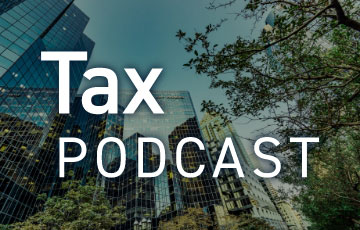Overview of the Final Regulations
On January 3, 2025, the U.S. Department of Treasury released final regulations for the Internal Revenue Code (IRC) Section 45V tax credit, which was originally created as part of the Inflation Reduction Act of 2022.
Coming almost a year after the previously published proposed rules in 2023, these final regulations cover the production tax credit (PTC) for hydrogen and were accompanied by the U.S. Department of Energy's release of the 45VH2-GREET Model. While the final regulations provide helpful guidance and resolve some contentious issues, they are not entirely taxpayer friendly.
IRC Section 45V Hydrogen Tax Credit: Key Features
IRC Section 45V offers a PTC for the production of qualified clean hydrogen at a qualified facility. This credit applies to production after December 31, 2022, during the 10-year period beginning on the date the facility is originally placed in service.
Taxpayers may also elect to treat a portion of a specified clean hydrogen facility as energy property for the IRC Section 48 energy investment credit.
Calculation of the 45V Tax Credit
The energy tax credit amount is calculated based on the kilograms (kg) of qualified clean hydrogen produced during the taxable year, varying with the process's lifecycle greenhouse gas (GHG) emissions.
Meeting the prevailing wage and apprenticeship requirements (PWA) can maximize the credit to $3 per kg, provided GHG emissions are less than 0.45 kgs of carbon dioxide equivalent (CO2e) per kg. The credit amount is calculated as the applicable percentage of $0.60. If the resulting figure is not a multiple of $0.01, it can be rounded to nearest multiple.
Verification by an unrelated third party is required to confirm that the clean hydrogen was produced in the U.S. for sale or used in the ordinary course of the taxpayer's trade or business.
|
Carbon Dioxide per kg |
Applicable Percentage |
Maximum Credit Amount |
|
0 – < 0.45 kgs |
100% |
$3.00 |
|
≥ 0.45 – < 1.5 kgs |
33.4% |
$1.00 |
|
≥ 1.5 – < 2.5 kgs |
25% |
$0.75 |
|
≥ 2.5 – < 4.0 kgs |
20% |
$0.60 |
Hydrogen produced with more than 4 kgs of carbon dioxide will not qualify for the tax credit.
Section 45V Hydrogen Tax Credit Final Regulations: Important Details
The recently released final regulations for Section 45V provided clarification and information on several facets of this tax credit:
Emphasis on Energy Attribute Certificates (EACs)
The final regulations emphasize the three pillars of Energy Attribute Certificates (EACs), which verify claims to specific energy sources. If taxpayers acquire and retire EACs for each unit of electricity claimed, a facility's use of grid-connected electricity can be treated as coming from a specific generation facility. The final regulations maintain constraints on EAC eligibility, including requirements for temporal matching, incrementality and deliverability.
Requirements for the Three Pillars
As mentioned above, the Treasury has kept the requirements for the “three pillars” of clean energy:
Incrementality
The electricity used to produce clean hydrogen must come from new sources. Options to prove incrementality include electricity from certain nuclear facilities, sources with added carbon capture and sequestration technology and states with qualifying decarbonization standards (currently Washington and California).
Temporal Matching
The regulations require annual matching of EACs until January 1, 2030, after which hourly matching is required. Taxpayers can determine GHG emissions on an hourly basis using eligible EAC attributes.
Deliverability
EACs must come from the defined region corresponding to the balancing authority to which the hydrogen facility and the EAC source are interconnected.
Updates to the Calculation of the Credit
Taxpayers determine the energy tax credit amount using the kg of CO2e per kg of hydrogen based on the production process. For facilities using multiple processes, the credit is determined by the weighted average of GHG emissions from each process. New rules and definitions apply when carbon capture and sequestration is used in electricity production
Adoption of the GREET Model
The final regulations adopt the 45VH2-GREET model as the sole model for determining well-to-gate GHG emissions for the Section 45V credit. The 45VH2-GREET user manual was updated in January 2025 to cover the calculation methodology and provide instructions for using the model.
Additional Considerations for IRC Section 45V Final Regulations
- The final regulations discard the proposed range of methane percentages for biogas.
- Temporal matching can be adjusted based on stored electricity discharge.
- Hydrogen production must not be wasteful, and the purpose should not solely be to claim the Section 45V credit.
Clean Hydrogen Tax Credit Frequently Asked Questions
Section 45V of the Internal Revenue Code allows for a tax credit on the production of clean hydrogen at a qualified facility. It was established as part of the Inflation Reduction Act of 2022.
IRC Section 45V has three pillars: incrementality, temporal matching and deliverability.
The 45V tax credit originally required that clean power generation must match the hydrogen production on an hourly basis beginning in 2028. However, the finalized regulations prolonged the period, allowing annual matching up to January 1, 2030. After that point, hourly matching will be required.
No, unfortunately, taxpayers cannot stack both Section 45Q and 45V tax credits for the same equipment or facility.
GREET (greenhouse gases, regulated emission and energy use in technologies) was created to help determine the environmental impact of energy systems, fuels and technology. The 45VH2-GREET model was created to calculate the well-to-gate emissions rate for the clean hydrogen tax credit.
Your Guide Forward
Given the intricacies of these regulations, taxpayers should consult Cherry Bekaert’s Energy Tax Credit & Incentive Advisory team to ensure compliance and maximize benefits. Reach out to Cherry Bekaert for our experienced team members’ guidance on navigating these final regulations.







